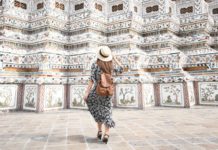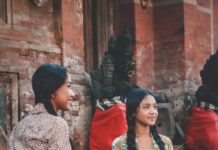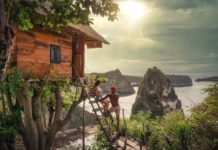Ten years after her first visit, Julienne R returns to Cambodia to reconnoiter the mystical temple landscape and figure out what to do in Siem Reap in 48 hours…
This is the original, unedited version of a story published on Gafencu Magazine Hong Kong May 2018 print issue

“Third time in Angkor Wat, and even after Petra and Machu Picchu, there is still something so wild and ethereal about these jungle temples.” These were the words scribbled hastily on the writer’s journal dated January 14, 2018. “Being here again reminds me how magical and wonderful Asia is when – having lived here most of my life – I tend to take it for granted.”
The Siem Reap of today is a far cry from what it was in the turn of the millennium. Whereas before the market would be filled with archeological enthusiasts and curious backpackers, on a bad day you might find it packed with tourists driven in by the busload. At major temples, where you used to hear the wild sounds of the jungle, you might find yourself constantly dodging tour guides yapping away in several languages.
Before you recoil in disgust, dear reader, there is yet good news to be had: Siem Reap and its locals have not lost their charm, you just need to look harder to find it.

“Are you Khmer?” If you in any way look Southeast Asian, you might be presented with this question during your trip. “If you are – or at least one of your parents is – then you get in for free,” grinned our tour guide, as we paid US$37 for a day ticket at the white marbled entrance to the Angkor Archaeological Park.
The main sites of the Angkor
We awoke well before dawn that morning to catch the sun climbing Angkor Wat’s spires. It was early January, the weather gloriously cool and sunny, hitting 13°C at daybreak. Without a doubt winter is the best time to visit, when it’s bright and dry compared to the stifling heat and humidity of summer.
Tourist numbers weren’t overwhelming that day, and we were able to stroll around the mythological city relatively unbothered. First timers can’t miss the main temple of Angkor Wat, whose area alone is 820,000 sqm (203 acres), bounded by a wide moat. The park is more than double that size (up to 400 sq km), not counting the medieval cities yet to be discovered. According to the latest lidar (light detection and ranging) surveys, much of the 12th century’s “largest empire on earth” remains hidden beneath the jungle.

At the park, life-size sculptures depict elephants pulling gigantic stones to illustrate how the site was built. Believe it or not, the city’s builders managed the feat without the technology of the wheel – only hundreds of elephants pulling gigantic stones from the quarry and rolling them over logs.
Angkor Thom, or “Great City” in Khmer, should be added on your list of what to do in Siem Reap, as it is another must, guarded by 54 demons on its south gate. Its most defining characteristics include the naga (great snake) bridge leading into the walled city; the smiling stone faces of the Buddhist Bayon temple; and the Terrace of the Elephants.
The annual Angkor Wat International Half Marathon passes through the main thoroughfare here every December, and if you’re interested to run in the area prior, you might want to get off the beaten path and find yourself tracking paths leading to nowhere, elephant statues walking into the overgrowth and massive abandoned temples scattered about.
The final “unmissable” of the golden three is the photographer’s paradise of Ta Prohm, famous for giant trees growing over the ruins, their immense roots snaking around the crumbling walls.

Authentic Cambodia: Off the beaten path
Most travellers get their introduction to the Angkor by way of walking with a travel guide; however, there are many alternatives to this traditional experience. Get away from the main drag via bicycle, as many do. Guided bike tours can take you through the “original temples”, or further out through fields and small villages. Trip Guru’s “Pedals and Paddles” tour even combines cycling with kayaking through the floating villages of Tonlé Sap lake, a UNESCO biosphere reserve.
If you’re looking for a faster ride, the options are many and varied, ranging from horseback riding and vespa tours to helicopters and ultra-light flights. Extreme adventurers will love the thrill of motorbiking and trekking up to the sacred mountain of Kulen, birthplace of the Khmer Empire.

However, most have come for temples and might want to follow the path to its end. Escape the madding crowds at outlying temples Beng Mealea and Koh Ker, which you will most likely be be able to enjoy in solitude. There are also those unnamed Buddhist ruins towards West Baray, accessed only through the jungle.
Where to stay & eat: Anantara Angkor
With all that daytime exploring, you’ll need a tranquil base to come home to; we couldn’t recommend Anantara Angkor more. Unlike the big hotels crowding the strip from airport to temple, the Anantara is a boutique property that maintains the locale’s architecture, traditions and sense of place. Each of the 39 suites are created in the grand Khmer style; all handcrafted teak furniture, rich local textiles and carved sandstone.
Almost all private balconies have their own ponds and look on to the sparkling pool and courtyard, next to the 7-year-old hotel’s Chi Restaurant. Here, Chef Kien Wagner cooks up progressive Khmer cuisine that would impress even the most discerning of palates. During our Chef’s Table dinner, when Wagner whipped up his creations by our tableside, we discovered that he originally came to the country five years ago from Germany as a volunteer to train Cambodians in culinary arts. The young chef fell in love with the place and ended up staying after marrying a local Cambodian. “She’s the one who trained me in Cambodian cuisine,” he admits.

Order the Cambodian Saraman Curry of braised lamb shanks with peanuts, sweet basil and crunchy baguette. Even more delicious are the river prawns, a Mekong specialty. Wagner goes to the markets himself on a regular basis to find the best local ingredients.
Third time’s the charm, began the last paragraph of the author’s diary entry from the trip. Siem Reap has grown into its own after all these years, as have I. No longer the traveller I was back then, I’m happy I came back to experience Cambodia in a slower and more lavish manner.
Several years of mainstream tourism might have made the temple landscape of northern Cambodia a well-trodden path, but thankfully, much of the development has been mindful of local tradition. Whether you’re coming for the first time or for the third time, your journey is sure to unravel something different and possessed of a charm of its own. I certainly wouldn’t say no to coming back for more.
Photos courtesy of Angkor Anantara










Thank you for sharing! We are going there in November, and I am looking very much forward to it 🙂 Happy you weren’t swamped with other tourists when you visited Angkor Wat – hope that will be the same for us too 🙂
Thanks to the excellent guide
Thanks, it is very informative